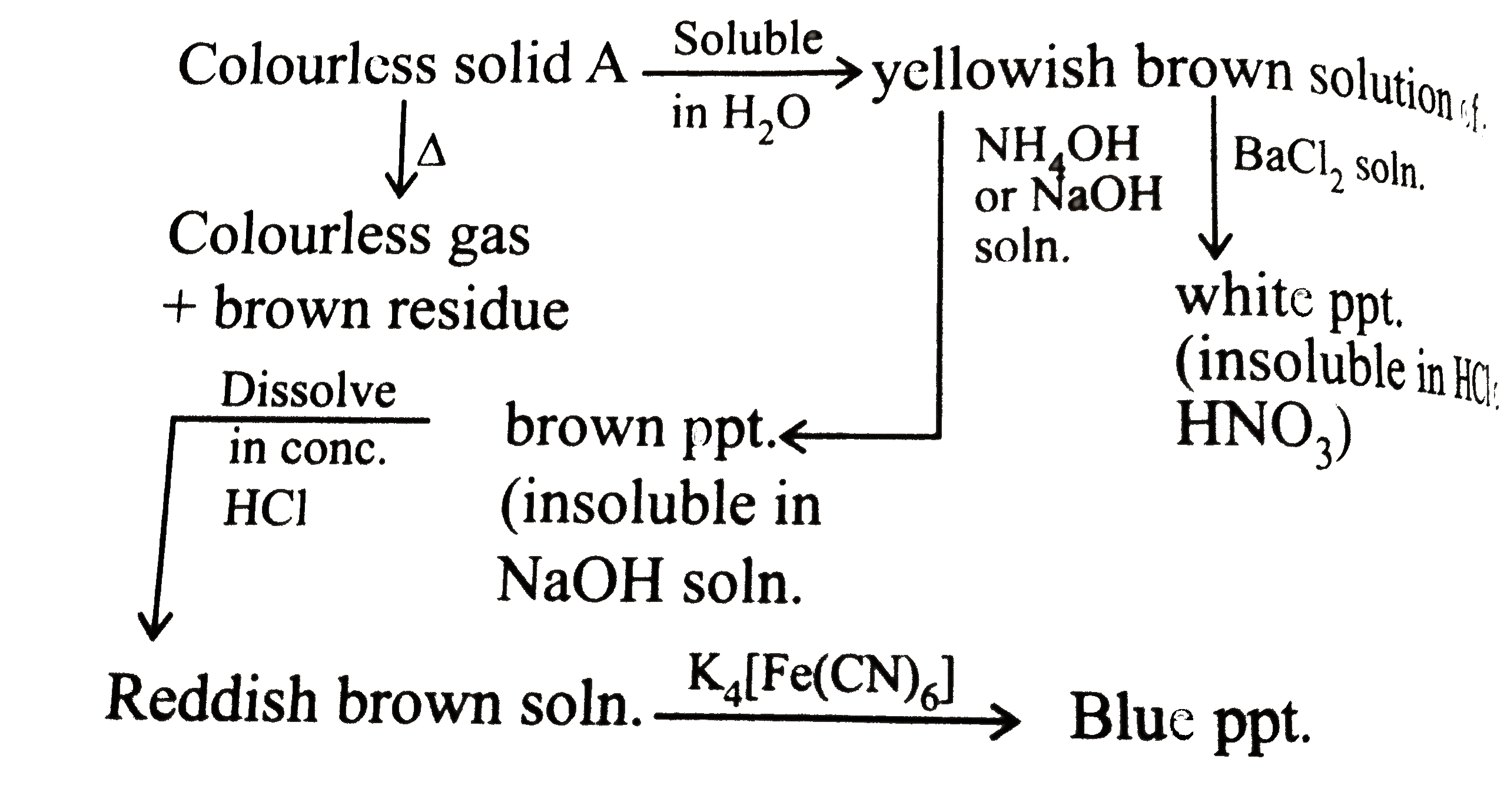The reagents like AgNO3,K4[fe(CN)6],KCNS,KI,K2CrO4 Nessler's ect, find extenstive and very important applicasion in quentitative analysis because these resgents form different type of produce with different cation for axample KI form yellow precipitate with Pb2+ but at form red iprecipitate with Hg2+ , Hence these reagents are widely used in the quantitative amalysis of morgenic salts
Which of the following cation (i.e. basic radicals) forms coloured (not white) percipitates with aqueous solution of potassium iodide the precipitete does not dissolve is exiess og reagent?
Hg2+
Hg2+2
Bi3+
Cu2+
The correct Answer is:b
To solve the question, we need to determine which cation forms a colored precipitate with potassium iodide (KI) that does not dissolve in excess reagent. Let's analyze the given options step by step.
Step 1: Analyze the Cations
We have four cations to consider:
1. Hg²⁺ (Mercuric ion)
2. Hg₂²⁺ (Mercurous ion)
3. Bi³⁺ (Bismuth ion)
4. Cu²⁺ (Copper ion)
Step 2: Reaction with Potassium Iodide (KI)
- Hg²⁺ (Mercuric ion):
- When reacted with KI, it forms a red or scarlet precipitate of HgI₂.
- However, this precipitate dissolves in excess iodide ions to form a soluble complex, HgI₄²⁻.
- Conclusion: Does not satisfy the condition.
- Hg₂²⁺ (Mercurous ion):
- When reacted with KI, it forms a green precipitate of HgI₂.
- In excess iodide, it does not dissolve but instead forms HgI₄²⁻ and a black precipitate of elemental mercury (Hg).
- Conclusion: Satisfies the condition of forming a colored precipitate that does not dissolve in excess reagent.
- Bi³⁺ (Bismuth ion):
- When reacted with KI, it forms a black precipitate of BiI₃.
- This precipitate dissolves in excess iodide to form a soluble complex, BiI₄⁻.
- Conclusion: Does not satisfy the condition.
- Cu²⁺ (Copper ion):
- When reacted with KI, it forms a white precipitate of CuI.
- Conclusion: Does not satisfy the condition as it must be colored.
Step 3: Conclusion
Based on the analysis, the only cation that forms a colored precipitate with potassium iodide and does not dissolve in excess reagent is the mercurous ion, Hg₂²⁺.
Final Answer
The cation that forms a colored (not white) precipitate with aqueous potassium iodide that does not dissolve in excess reagent is Hg₂²⁺ (Mercurous ion).
---
We have four cations to consider:
1. Hg²⁺ (Mercuric ion)
2. Hg₂²⁺ (Mercurous ion)
3. Bi³⁺ (Bismuth ion)
4. Cu²⁺ (Copper ion)
- Hg²⁺ (Mercuric ion):
- When reacted with KI, it forms a red or scarlet precipitate of HgI₂.
- However, this precipitate dissolves in excess iodide ions to form a soluble complex, HgI₄²⁻.
- Conclusion: Does not satisfy the condition.
- When reacted with KI, it forms a green precipitate of HgI₂.
- In excess iodide, it does not dissolve but instead forms HgI₄²⁻ and a black precipitate of elemental mercury (Hg).
- Conclusion: Satisfies the condition of forming a colored precipitate that does not dissolve in excess reagent.
- When reacted with KI, it forms a black precipitate of BiI₃.
- This precipitate dissolves in excess iodide to form a soluble complex, BiI₄⁻.
- Conclusion: Does not satisfy the condition.
- When reacted with KI, it forms a white precipitate of CuI.
- Conclusion: Does not satisfy the condition as it must be colored.
Based on the analysis, the only cation that forms a colored precipitate with potassium iodide and does not dissolve in excess reagent is the mercurous ion, Hg₂²⁺.
The cation that forms a colored (not white) precipitate with aqueous potassium iodide that does not dissolve in excess reagent is Hg₂²⁺ (Mercurous ion).
Topper's Solved these Questions
- QUALITATIVE INORGANIC SALT ANALYSISBook:CENGAGE CHEMISTRY ENGLISHChapter:QUALITATIVE INORGANIC SALT ANALYSISExercise:Exercises (Multiple Correct) Part-A (Analysis Of Anions)
Explore 30 Videos
- QUALITATIVE INORGANIC SALT ANALYSISBook:CENGAGE CHEMISTRY ENGLISHChapter:QUALITATIVE INORGANIC SALT ANALYSISExercise:Exercises (Multiple Correct) Part-B (Analysis Of Cations)
Explore 28 Videos
- QUALITATIVE INORGANIC SALT ANALYSISBook:CENGAGE CHEMISTRY ENGLISHChapter:QUALITATIVE INORGANIC SALT ANALYSISExercise:Solved Example
Explore 11 Videos
- P-BLOCK GROUP 18 ELEMENTS - THE INERT GASESBook:CENGAGE CHEMISTRY ENGLISHChapter:P-BLOCK GROUP 18 ELEMENTS - THE INERT GASESExercise:Ex 5.1 (Objective)
Explore 14 Videos
- REDUCTION AND OXIDATION REACTION OF ORGANIC COMPOUNDSBook:CENGAGE CHEMISTRY ENGLISHChapter:REDUCTION AND OXIDATION REACTION OF ORGANIC COMPOUNDSExercise:SUBJECTIVE TYPE
Explore 4 Videos
Similar Questions
The reagents like AgNO3,K4[Fe(CN)6],KCNS,KI,K2CrO4 Nessler's ect, find extenstive and very important applicasion in quentitative analysis because these resgents form different type of produce with different cation for axample KI form yellow precipitate with Pb2+ but at form red iprecipitate with Hg2+ , Hence these reagents are widely used in the quantitative amalysis of morgenic salts
Which of the following is not currectly matched ?
View SolutionThe reagents like AgNO3,K4[Fe(CN)6],KCNS,KI,K2CrO4 Nessler's ect, find extenstive and very important applicasion in quentitative analysis because these resgents form different type of produce with different cation for axample KI form yellow precipitate with Pb2+ but at form red iprecipitate with Hg2+ , Hence these reagents are widely used in the quantitative amalysis of morgenic salts
Which of the following hydroxide does not dissolve in ammounium solution but disolves in sodium hydroxide ?
View Solution
Knowledge Check
Ammonia is a Lewis base. It forms complexes with cations. Which one of the following cations does not form complex with ammonia?
AAg+BCu++CCd++DPb++
Which of the following cations form(s) black precipitate(s) with H2S(g) ?
View Solution
Which of the following complex is formed when A reacts with K4[Fe(CN)6]?
View SolutionWhich of the following cations will form an insoluble red-brown compound with [Fe(CN)6]4− ?
View SolutionWhich of the following atom would likely form a cation.
View SolutionWhich basic radicals form oxo-cations in aqueous solutions ?
View SolutionCompound (P) forms a precipitate with AgNO3. The precipitate dissolves in excess reagent (P). (P) cannot be:
View SolutionK4[Fe(CN)6]+2CuSO4→Cu2[Fe(CN)6]⏐⏐↓
View Solution